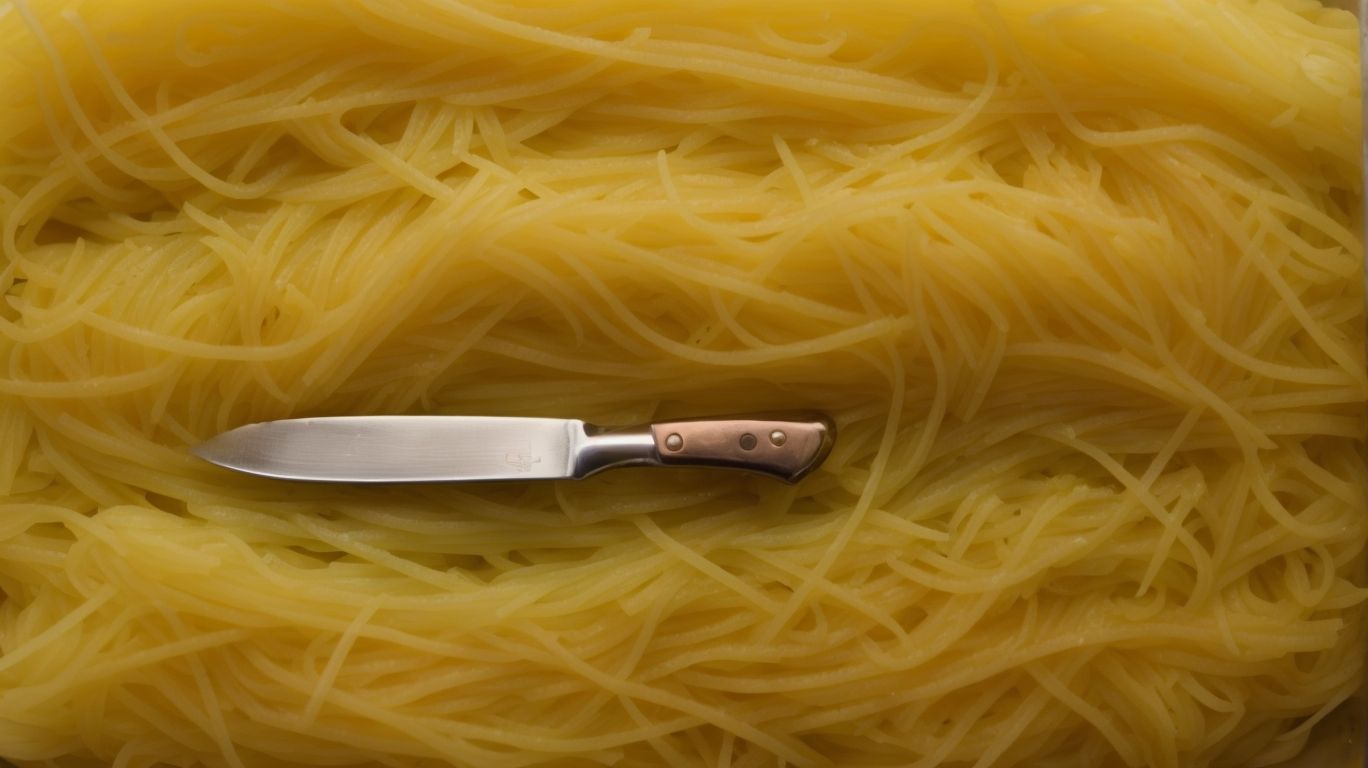How to Bake Whole Spaghetti Squash?
Are you looking for a healthy and delicious alternative to pasta? Look no further than spaghetti squash!
We explore what spaghetti squash is and how it differs from other squash varieties. Discover the benefits of baking the whole squash and learn how it compares to other cooking methods.
Get a step-by-step guide on how to bake whole spaghetti squash, serving suggestions, and storage tips for a culinary adventure that will tantalize your taste buds!
Key Takeaways:
What is Spaghetti Squash?
Spaghetti Squash, a versatile winter squash, is known for its unique stringy texture that resembles spaghetti strands when cooked.
“
Its mild flavor profile and ability to absorb flavors make it a popular healthy alternative to pasta. When roasted, the flesh of the squash easily shreds into long, thin strands, perfect for twirling around a fork. It can be used in a variety of dishes, such as:
- spaghetti squash casserole
- spaghetti squash with marinara sauce
- spaghetti squash stuffed with vegetables and cheese
The squash’s low calorie and carbohydrate content also contribute to its popularity among those looking to maintain a balanced diet. Spaghetti squash offers a delicious and nutritious option for anyone seeking a light and flavorful meal.
How Does Spaghetti Squash Differ from Other Squash Varieties?
Spaghetti Squash stands out from other squash varieties due to its stringy texture and mild, slightly sweet flavor that transforms when cooked.
When compared to butternut or acorn squash, spaghetti squash has a unique characteristic in that its flesh separates into thin, spaghetti-like strands after cooking, hence its name. The texture is more fibrous and less dense than other squashes, giving it a light and satisfying mouthfeel. The flavor profile of spaghetti squash is subtle, making it a versatile ingredient that can easily take on the flavors of various seasonings and sauces.
Why Bake Whole Spaghetti Squash?
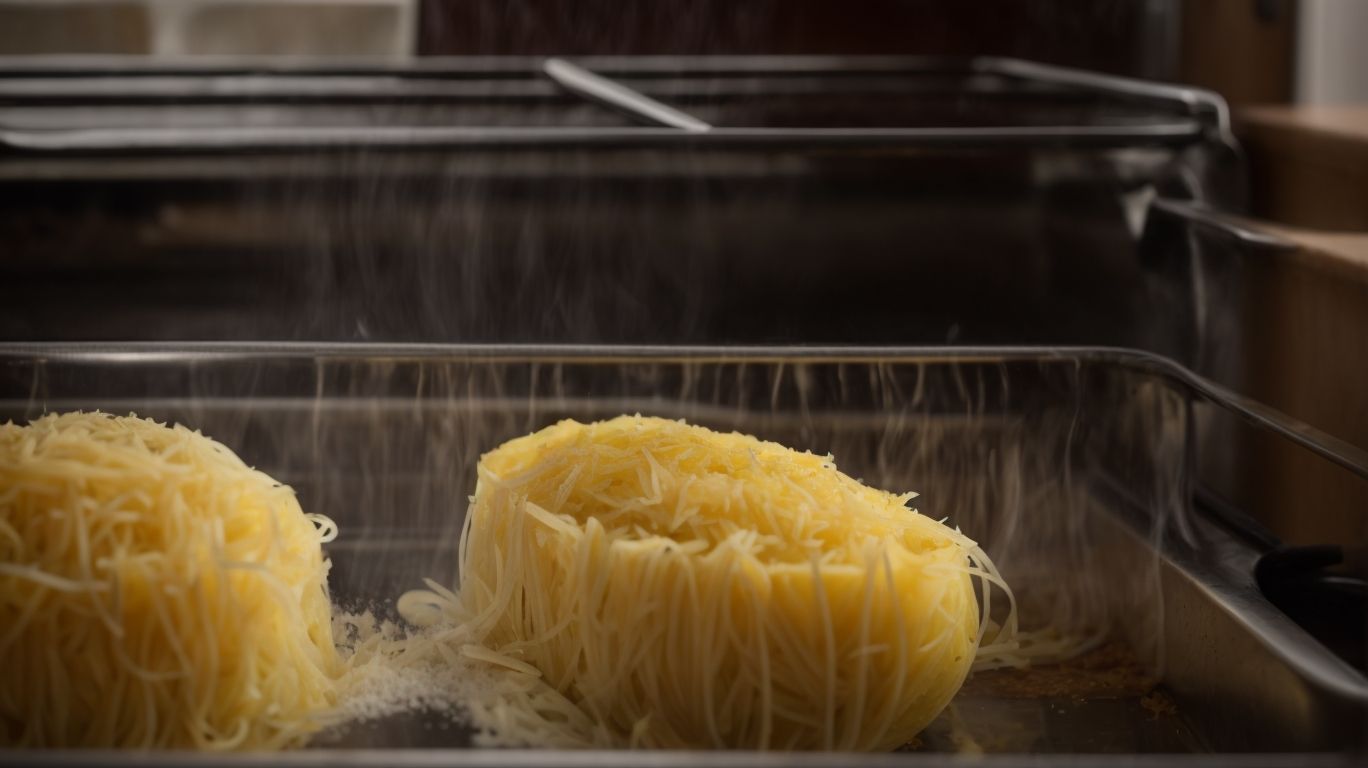
Credits: Poormet.Com – Larry Lewis
Baking whole spaghetti squash offers an easy and convenient way to cook this nutritious vegetable while preserving its natural flavors and nutrients.
The advantage of baking whole spaghetti squash lies in the way it locks in the vegetable’s fresh flavors and nutrients, resulting in a dish that bursts with natural goodness.
By baking it whole, the flesh of the squash remains moist and tender, enhancing the overall taste and texture. This method helps to retain the valuable vitamins, minerals, and fiber present in the vegetable, ensuring that you get the maximum nutritional benefits from your meal.
The process of baking whole spaghetti squash is incredibly simple – just pierce the skin, place it in the oven, and let it roast to perfection, making it an ideal option for those looking for a hassle-free cooking experience.
Benefits of Baking Whole Spaghetti Squash
Baking whole spaghetti squash retains its inherent nutrients, simplifies preparation, and enhances its natural flavors, making it a wholesome and delicious dish.
Spaghetti squash is packed with essential nutrients like vitamin C, vitamin A, potassium, and fiber, which support immune function, eye health, and digestion.
By baking the squash whole, you preserve these nutrients better than traditional boiling or microwaving methods.
The convenience of baking the squash whole eliminates the tedious task of cutting through its tough skin, allowing for an easier cooking process.
The slow roasting enhances the natural sweetness of the squash, providing a caramelized flavor that pairs beautifully with various seasonings and sauces.
How Does Baking Whole Spaghetti Squash Compare to Other Cooking Methods?
Baking whole spaghetti squash offers a simpler and more hands-off approach compared to other cooking methods, resulting in tender, flavorful strands ideal for various recipes.
When baking a whole spaghetti squash, the thick outer skin acts as a natural vessel, locking in moisture and infusing the flesh with rich flavor as it roasts. The gentle heat of the oven allows the strands to steam and soften slowly, creating a perfectly tender texture that retains a slight bite for a satisfying mouthfeel. This method also enhances the natural sweetness of the squash, making it versatile for both savory and sweet dishes.
What You Will Need to Bake Whole Spaghetti Squash
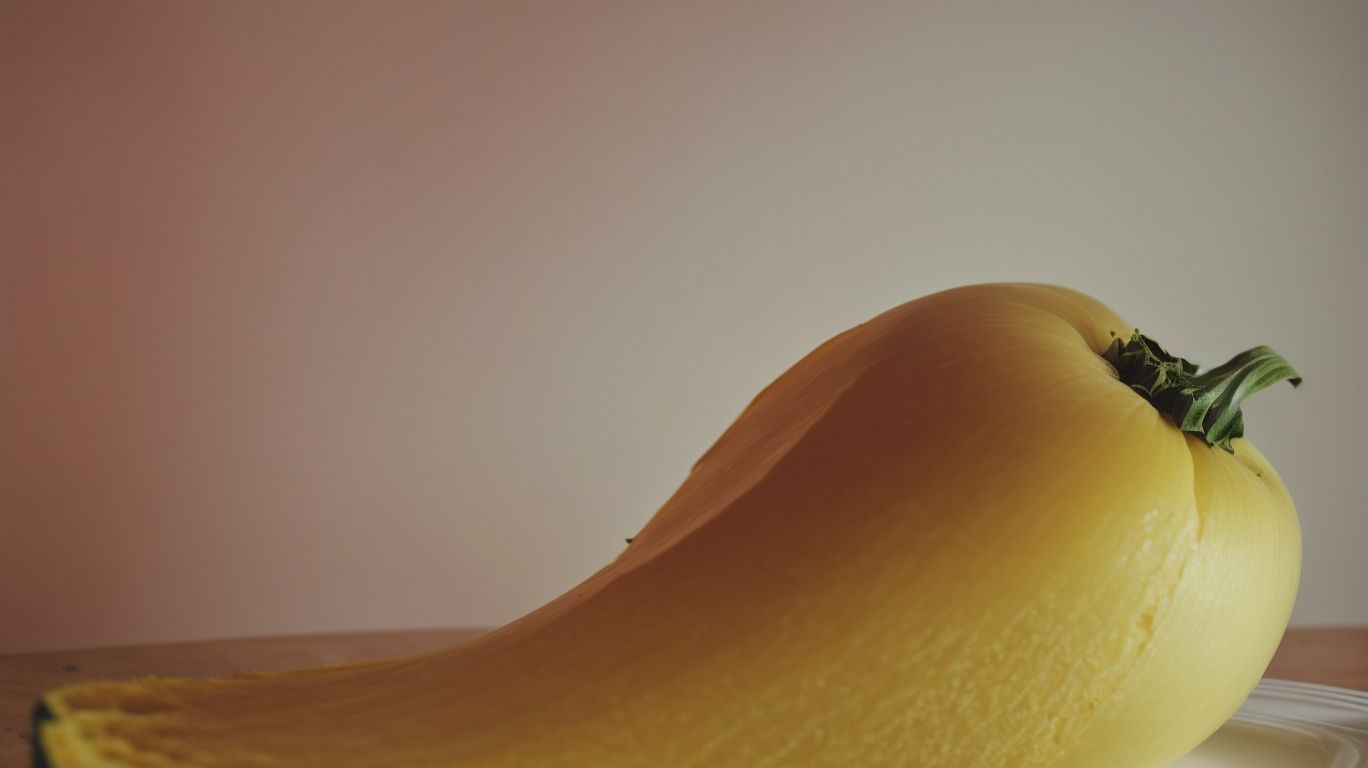
Credits: Poormet.Com – Paul Adams
To bake whole spaghetti squash, you will need simple ingredients like olive oil, salt, and pepper, along with essential tools such as a sharp knife and a baking sheet.
It’s handy to have a sturdy cutting board to safely slice through the tough outer skin of the squash. A spoon will be helpful for scooping out the seeds and stringy bits from the center before baking. To ensure even cooking, a reliable oven thermometer is critical.
For seasoning, you can customize with garlic powder, paprika, or even a sprinkle of parmesan cheese for extra flavor. To protect your hands, oven mitts are vital when handling the hot baking sheet after cooking.
Ingredients
The key ingredients for baking whole spaghetti squash include the squash itself, olive oil for roasting, and seasonings like salt and pepper to enhance flavor.
When selecting your spaghetti squash, opt for ones that are firm with a vibrant yellow color, indicating ripeness. A good-quality olive oil is crucial for roasting to ensure the squash caramelizes beautifully and develops a rich flavor profile. Consider enhancing the dish further with fresh herbs such as rosemary or thyme for added complexity. For a touch of sweetness, a sprinkle of brown sugar or a drizzle of honey can balance the savory notes perfectly. Experiment with various seasonings and spices like garlic powder, paprika, or cayenne pepper to customize the taste to your preference.
Tools
Prepare for baking whole spaghetti squash by ensuring you have a sharp knife for cutting, a sturdy baking sheet for roasting, and a reliable fork for scraping out the cooked strands.
Once you have assembled these crucial tools, begin by preheating your oven to 400°F (200°C) to ensure the squash cooks evenly. Next, using the sharp knife, carefully cut the spaghetti squash in half lengthwise. Remember to scoop out the seeds and fibers using a spoon or a scoop to prepare for baking.
Place the squash halves cut-side down on the baking sheet to roast for approximately 45-60 minutes. You can enhance the flavor by brushing olive oil on the flesh and seasoning with salt, pepper, or your favorite herbs for added taste.
After the squash is tender and easily pierced with a fork, remove it from the oven and let it cool slightly before using the fork to scrape out the spaghetti-like strands. This step requires a gentle hand to avoid damaging the squash itself.
Step-by-Step Guide to Baking Whole Spaghetti Squash
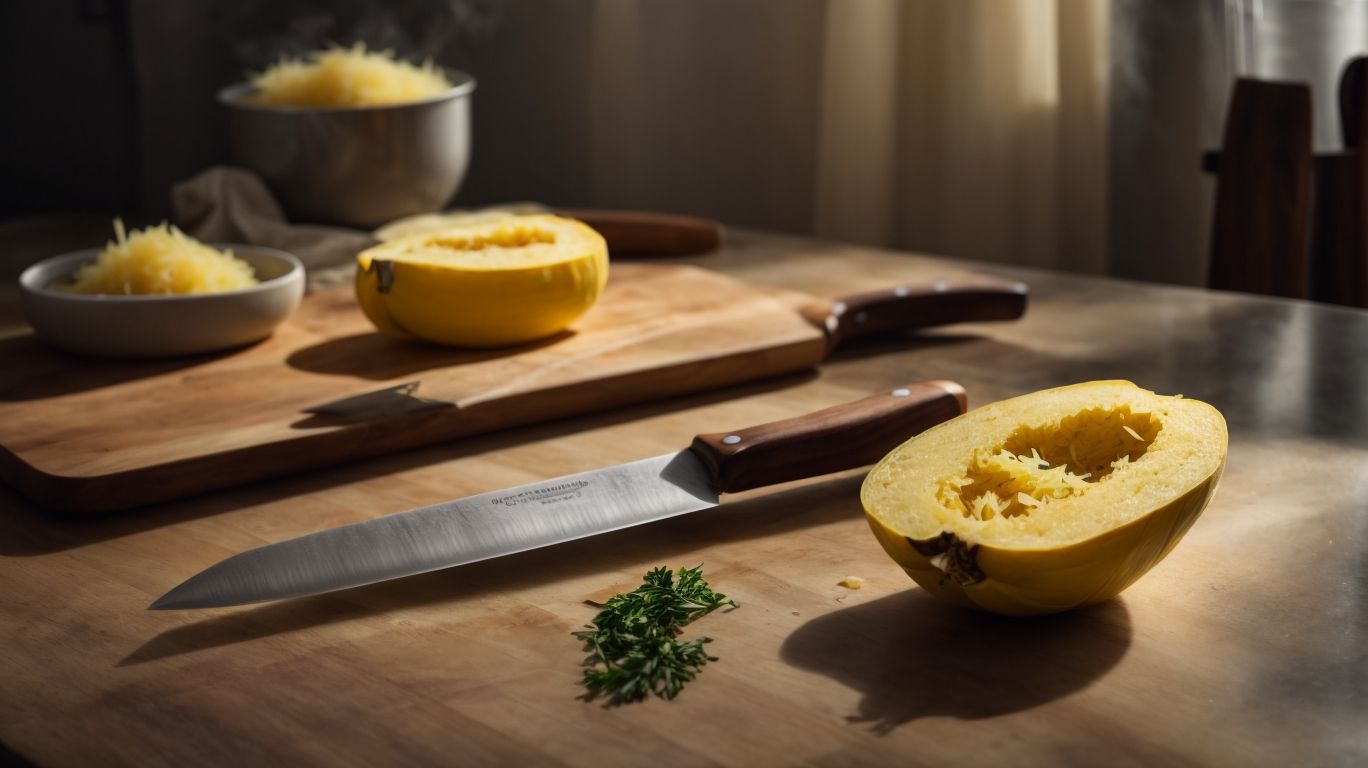
Credits: Poormet.Com – Donald Roberts
Follow these simple steps to bake whole spaghetti squash to perfection, yielding tender strands with a spaghetti-like texture that’s ready to be enjoyed in your favorite recipes.
To start, preheat your oven to 375°F. Using a sharp knife, carefully slice the spaghetti squash in half lengthwise and scoop out the seeds with a spoon. Place the halves cut-side down on a baking sheet lined with parchment paper. Bake in the oven for about 40-50 minutes or until the flesh is tender and can easily be pierced with a fork.
Once cooked, let the squash cool slightly before using a fork to scrape out the strands. The texture should be delicate and stringy, resembling traditional spaghetti noodles. These strands are versatile and can be used as a low-carb alternative in various dishes.
Step 1: Preheat the Oven
Begin by preheating your oven to the recommended temperature for baking whole spaghetti squash, ensuring even cooking and optimal flavor development.
Preheating the oven is a critical initial step in the process of preparing a delicious spaghetti squash dish. Setting the oven temperature to 375°F to 400°F is usually ideal for achieving the perfect texture and taste. This temperature range allows the squash to cook through evenly without overcooking or drying out. By preheating your oven properly, you create the ideal environment for the natural flavors of the spaghetti squash to develop and intensify during the baking process.
Step 2: Prepare the Squash
Prepare the squash by carefully cutting it in half using a sharp knife on a stable cutting board, ensuring safety and ease of handling during the baking process.
Before diving into the cutting process, it’s essential to wash the squash thoroughly to remove any dirt or impurities from the skin. Rinse it under cold running water and pat it dry with a clean kitchen towel. This not only ensures food safety but also prevents any contamination during preparation.
When handling the knife, make sure it is sharp to avoid slipping and causing accidents. Hold the squash firmly with one hand while using the knife with the other. Always slice away from your body to prevent injuries and maintain control over the cutting direction.
Step 3: Bake the Squash
Place the prepared squash halves on a baking sheet and bake them in the oven until the strands turn tender and achieve a spaghetti-like texture, following the recommended temperature guidelines for optimal results.
To ensure the perfect spaghetti squash texture, keeping track of the cooking times is crucial as different sizes of squash may vary in their required duration in the oven. For smaller squash, around 30-40 minutes at 400°F can yield beautifully tender strands, while larger squash might need up to 60 minutes or more. Keep a close eye on the progress to avoid overcooking, which can result in mushy strands instead of the desired al dente consistency.
Step 4: Remove from Oven and Let Cool
Once the squash is roasted to perfection, remove it from the oven and allow it to cool slightly before handling, ensuring safe and comfortable scraping of the cooked strands.
When taking the roasted squash out of the oven, remember to use oven mitts or a thick towel to protect your hands from the heat. Place the baking tray on a heat-resistant surface to cool down. Avoid placing it on a delicate surface that might get damaged due to the heat. Let the squash sit for a few minutes, allowing it to cool to a manageable temperature for handling.
Step 5: Scrape Out the Squash Strands
Using a fork, gently scrape out the cooked strands from the squash halves, marveling at the spaghetti-like texture that emerges, perfect for creating your favorite low-carb pasta dishes.
As you scrape the strands delicately, you will notice how effortlessly they separate, resembling traditional spaghetti strands. The texture is light and slightly crispy on the edges, providing a satisfying bite. To achieve longer strands, gently pull the fork in long strokes along the flesh of the squash.
These strands can be used in various culinary applications, from simple aglio e olio with garlic and olive oil to hearty dishes like spaghetti squash primavera with an array of colorful vegetables. Its versatility makes it a go-to ingredient for those looking to reduce carb intake without sacrificing taste.
How to Serve and Store Baked Whole Spaghetti Squash
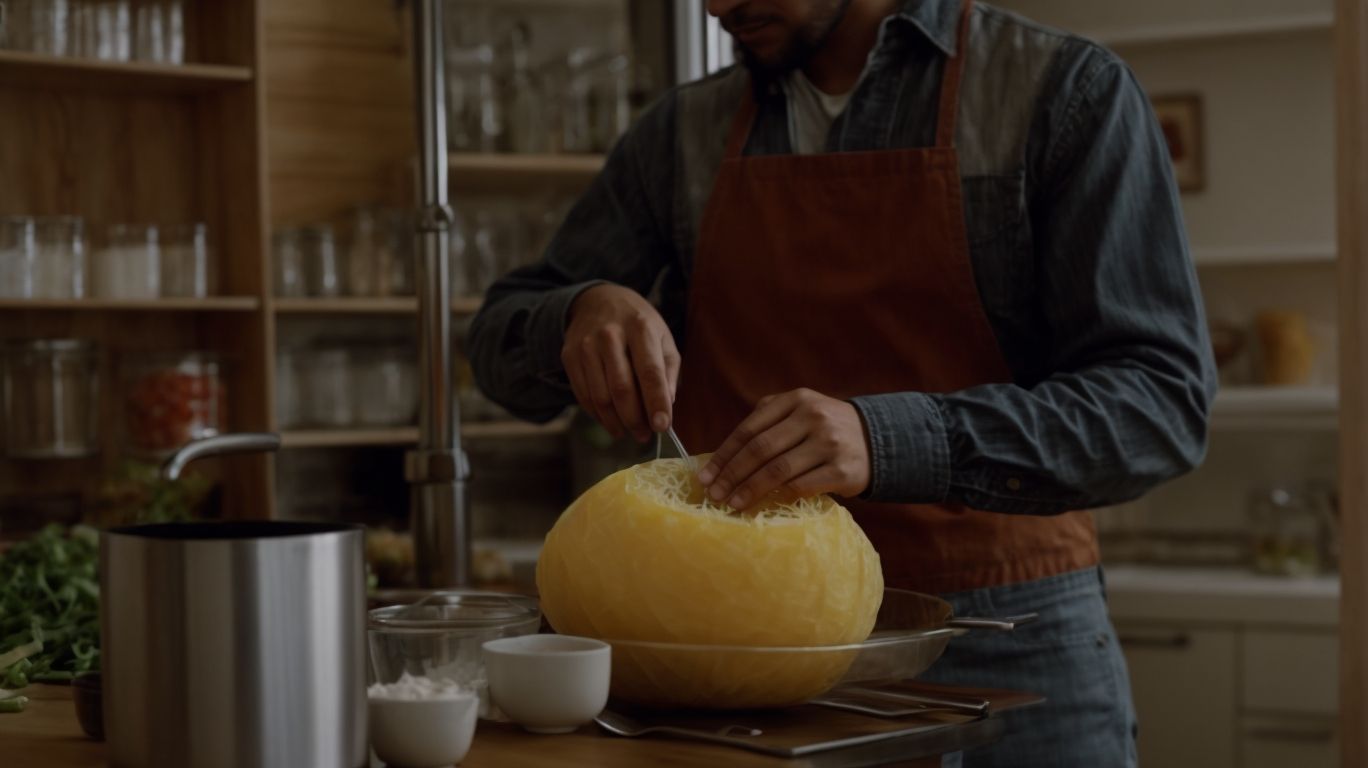
Credits: Poormet.Com – Dennis Green
Learn the best ways to serve and store baked whole spaghetti squash to preserve its flavor and texture for delicious meals and easy meal prep.
When serving baked whole spaghetti squash, a popular option is to simply scrape out the cooked flesh with a fork, creating spaghetti-like strands. These strands can be tossed with your favorite sauce or toppings, such as marinara sauce, garlic butter, or grated Parmesan cheese. Another creative idea is to use the squash halves as a natural bowl, filling them with a flavorful mixture of vegetables, meats, and cheeses for a unique presentation.
For storage, it’s best to let the squash cool completely before transferring it to an airtight container and refrigerating it. Properly stored, baked spaghetti squash can last in the fridge for up to 5 days. You can also freeze the cooked squash for longer-term storage by placing it in a freezer-safe bag or container. To maintain its quality, try to remove as much air as possible before sealing. When ready to use the frozen squash, let it thaw in the fridge overnight before reheating it in the oven or microwave.
Serving Suggestions
Enhance your dining experience with creative serving suggestions for baked whole spaghetti squash, incorporating it into your favorite recipes for easy and delicious meals.
- One delicious way to utilize baked spaghetti squash is to mix it with sautéed vegetables and top it with melted cheese for a flavorful vegetarian dish.
- For a heartier meal option, consider incorporating the spaghetti squash strands into a filling casserole with ground turkey, marinara sauce, and Italian seasoning.
- You can also pair baked spaghetti squash with grilled chicken or shrimp for a protein-packed meal that is both satisfying and nutritious.
- Don’t let leftover squash strands go to waste; transform them into a tasty stir-fry by adding soy sauce, ginger, garlic, and your favorite veggies.
Storage Tips
Discover effective storage tips to maintain the freshness and quality of baked whole spaghetti squash, enabling convenient meal prep and utilization in various dishes.
Regarding storing baked spaghetti squash, the method largely depends on your consumption timeline. If you plan to use it within a couple of days, refrigeration is your best bet. Wrap the cooled squash tightly in plastic wrap or store it in an airtight container in the refrigerator. Remember, refrigerated squash should ideally be consumed within 3-4 days for the best taste and texture.
If you want to extend the shelf life of your baked spaghetti squash, freezing is a great option. Prepare the squash as usual, let it cool completely, then transfer it to a freezer-safe bag or container, and seal tightly. Frozen spaghetti squash can last up to 6 months, offering a convenient option for future meals.
For meal prep purposes, consider portioning the baked spaghetti squash before storage. This makes it easier to defrost only what you need, minimizing waste and simplifying meal preparation. Whether you choose to refrigerate, freeze, or portion your baked spaghetti squash, these storage strategies ensure that you have this versatile ingredient readily available for your favorite recipes.
Frequently Asked Questions
What are the benefits of baking a whole spaghetti squash?
Baking a whole spaghetti squash allows the vegetable to retain its nutrients, flavor, and texture, making it a healthier and tastier option compared to other cooking methods.
How do I choose the right spaghetti squash for baking?
Look for a firm and heavy squash with a pale, even color. Avoid ones with soft spots, cuts, or dark spots, as they may be overripe or spoiled.
What is the best way to prepare the spaghetti squash for baking?
Cut off the stem and slice the squash in half lengthwise. Scoop out the seeds and place the halves in a baking dish, cut side down. You can also pierce the squash a few times with a fork to prevent it from bursting in the oven.
What temperature and how long should I bake the whole spaghetti squash?
Preheat the oven to 375°F and bake the squash for 40-50 minutes, depending on the size of the squash. Check for doneness by inserting a fork or knife into the flesh, which should be tender.
Do I need to add any seasoning or oil before baking the spaghetti squash?
It’s not necessary, but you can add some olive oil, salt, and pepper to enhance the flavor. You can also brush the squash with oil before baking to help it brown and caramelize.
What can I do with the baked spaghetti squash?
Once the spaghetti squash is baked, you can use a fork to scrape the flesh into long strands, resembling spaghetti. You can serve it as a healthy alternative to pasta, mix it with your favorite sauce, or use it in various recipes like casseroles, soups, and salads.

